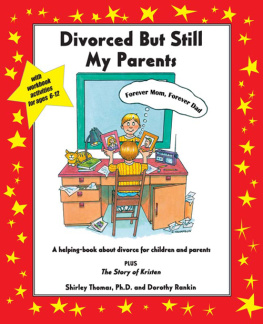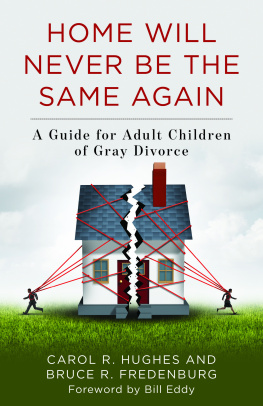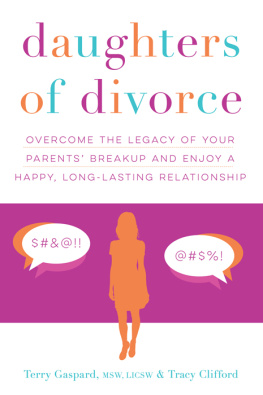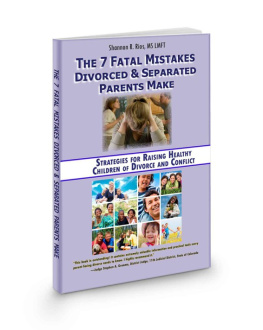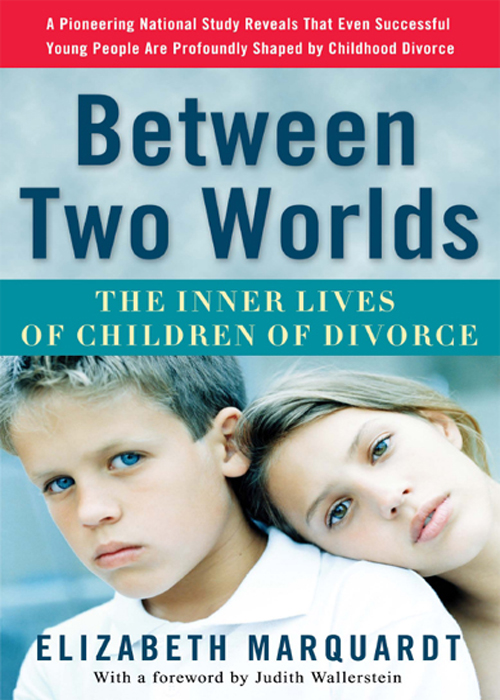
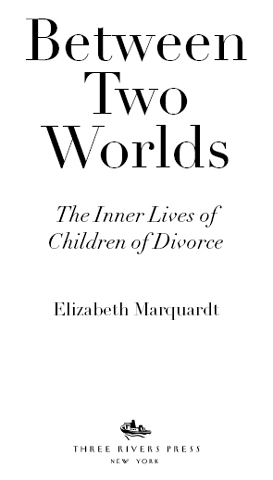
Contents
Introduction: What Is Not Known
About Our Generation
For Jim, for everything
Authors Note
W ith two exceptions noted in the text, the men and women quoted in these pages were participants in the study reported in this book. Although the names and identifying details of study participants have been changed to protect their confidentiality, all quotations are drawn directly from interview transcripts. Details about the interview setting were altered in some cases.
In order not to overload the text with numbers I have typically written about survey data in proportions (i.e., one-fifth, more than half), although at times I have used percentages when a proportion would be unclear. Percentages greater than 1 percent have been rounded off. Any reader wishing to know the exact percentages can find the full survey data at the end of this book.
Foreword
by Judith Wallerstein
T his eloquent, achingly honest story of a young womans growing up with divorced parents carries an important message for America. It is a powerful cry from the heart that touches us all. Drawing on a new national study of young men and women raised in divorced families, who today make up one quarter of the adult population, the author speaks for herself and her generation.
Hers is emphatically not a story of failure. On the contrary, the author today is a beloved young wife and a happy mother of two lovely children. She is also a college graduate. She grew up feeling loved by her parents, who separated when she was two years old and divorced the next year. Her parents remained civil with each other and tried their level best to work together on her behalf, and she continued to reside in both of their homes and to maintain close contact with each throughout her childhood.
Neverthelessand this is the startling message of this bookalong with many young adults she looks back with deep sorrow on a difficult childhood and a bewildering adolescence. These young adults recall how strange their childhoods seemed as they tried to remain connected with two homes, two parents who presented them with sharply different ideas and divergent values, and eventually, as parents remarried, two new families. The author speaks of how often she felt cut in half as she tried to bridge two worlds that spun further away from each other with each advancing year. Despite her eventual successes, she remains haunted to this day by memories of how hard she had to work to keep her balance in life and how lonely she so often felt. Like several children in my studies who told me poignantly, The day they divorced was the day my childhood ended, she envied those lucky children whose parents lived together. Her two homes, however loving, never enabled her to feel central to her parents lives or even really secure in their separate worlds.
Thus, no matter how impressive their achievements in adulthood, we learn that the self-image of adults raised in divorced families is still shaped by how burdened they felt as children. The author tells us poignantly how her search to feel whole occupied her energies for many years. She describes how adapting to the different lifestyles and values within her parents second families required her to become a chameleon, to keep secrets from each parent, to be extra discreet, to be hypersensitive to her parents moods, to play the game in ways that left her perpetually wondering about her own true identity. As one of the college students whom she interviewed in her study told her, It was just very hard to interact with my parents when I was growing up because they were separate. They were two different people, two different places, two different ideas. Nearly all of the young people describe long periods of loneliness while both parents were preoccupied with rebuilding their own lives. Many report the countless times they felt responsible for taking care of a distressed parent. And hardest of all, they describe how they had to figure out for themselves what was right and what was wrong. Because the moral guidelines from each parent conflicted, they had to create their own values and find within themselves the courage and the capacity to trust their own judgment and to make their own way in the world. As one of the young men in my studies told me, I had to become my own parent.
The study Elizabeth Marquardt conducted included extended face-to-face interviews with more than seventy college graduates between the ages of eighteen and thirty-five. She chose to focus on college graduates because she wanted to report the experiences of young people who were reasonably successful like herself. Half of the people she interviewed in person came from divorced families and half from intact homes. She spoke with each for several hours, asking a wide range of questions about their families, their experiences as children and as young adults, their relationships, their beliefs, and their values. All of the interviewees from divorced families had maintained contact with both parents and had experienced parental divorce before age fourteen. Some hailed from divorces where the parents were locked in conflict. Others were raised in good divorces like her own, where the parents were friendly and cooperated in their child rearing. Similarly, some of the intact families were harmonious, and in others the parents were in low or high conflict with each other.
Additionally, Elizabeth Marquardts book is based on questionnaire interviews with a random sample of fifteen hundred adults between the ages of eighteen and thirty-five, chosen from a national population. The questions were based on what Marquardt had learned from the personal interviews. Here, too, half of the sample was from divorced families and half was raised in intact families. The differences in the lives and responses of those who came from divorced families and those raised in intact families were striking even though some of those in intact families reported that their parents were unhappily married. As in my own work, Marquardts findings do not support the argument that the children will necessarily be unhappy in families where the adults are unhappy. And my own research showed clearly that children are often content in troubled families and are unaware of their parents marital disappointments if the parenting is sustained.
One interesting set of new observations she brings to our attention is that the young adults beliefs in God and in religious teachings and their affiliation with religious institutions were strongly affected by their parents divorce. Generally speaking, she tells us, adults from divorced families are less religious than those reared in intact homes. Fewer children of divorce belonged to religious institutions or attended services with their families. Many of the adolescents who did seek a religious connection went to services on their own. They described how they sat alone in the back pews, eyeing the intact families with children sitting in the front rows. And they reported sadly how rarely religious leaders approached them or responded to their troubled questions. We learn in this book that attitudes toward God often reflect a young adults feeling toward his or her parents and that parental divorce affects the way young people feel about religion. Many among those Marquardt interviewed connected their disapproval of one or both parents directly to their rejection of religious beliefs. Some described how their bitter anger at their parents led them to deny the existence of a caring God. For many, their search for a religious affiliation was associated with their longing for the stability and sense of safety that had eluded them in their divorced family.
Next page

